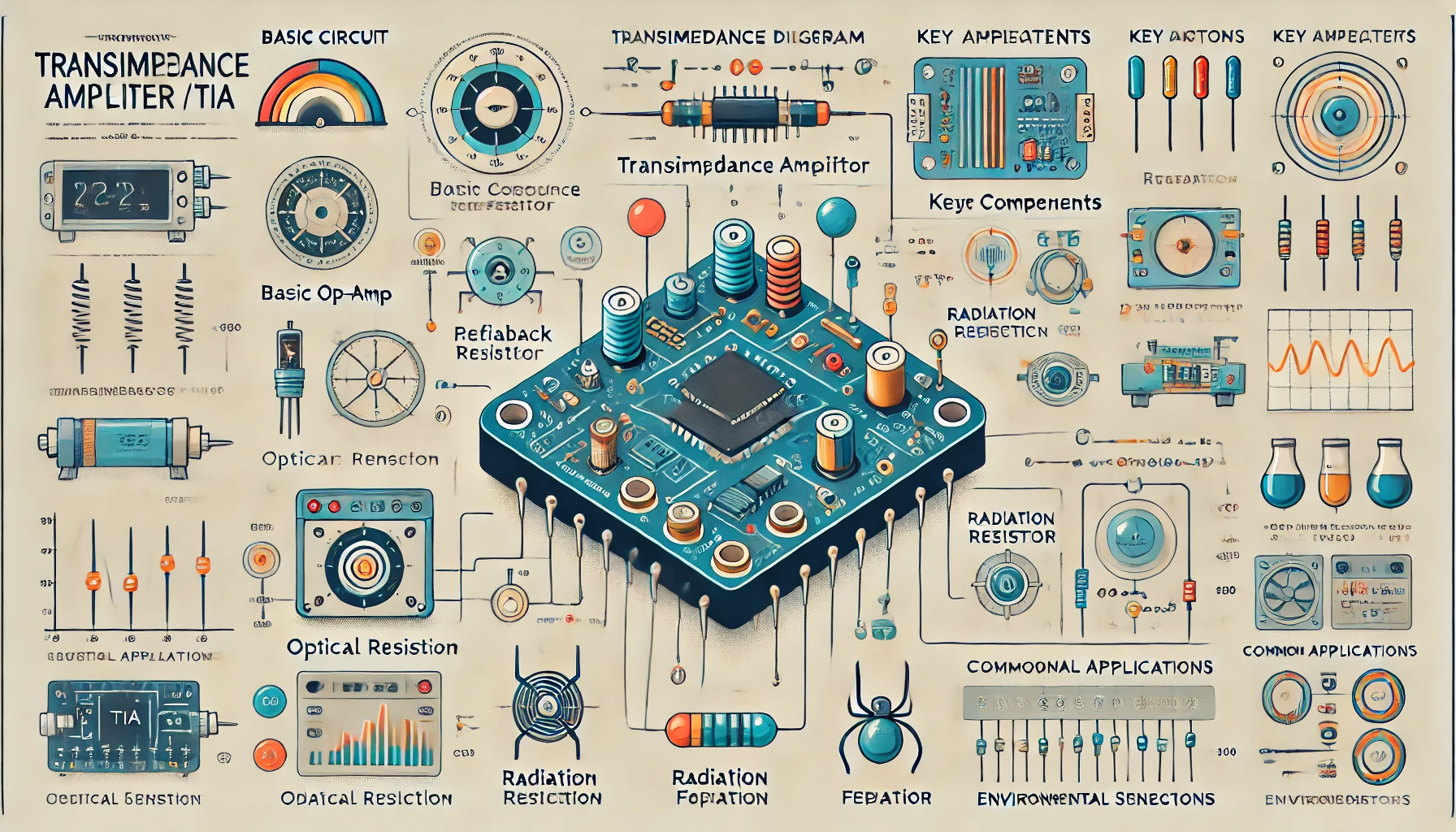What is a Transimpedance Amplifier? Understanding the Basics with Discoveringly
In the field of electronics, amplifiers play a crucial role in signal processing. Among the various types of amplifiers, the transimpedance amplifier (TIA) is a specialized type designed to convert small input currents into usable voltage outputs. This unique function makes TIAs essential in a variety of applications, including optical communication, sensor systems, and scientific instrumentation. In this guide, Discoveringly takes you through the fundamentals of what a transimpedance amplifier is, how it works, and where it’s used.
1. What is a Transimpedance Amplifier?
A transimpedance amplifier, often abbreviated as TIA, is an operational amplifier (op-amp) circuit that converts an input current into a corresponding output voltage. The term “transimpedance” refers to this conversion of current to voltage, which is achieved by using a feedback resistor in the circuit. The primary role of a TIA is to amplify very small currents from devices such as photodiodes or sensors, making the output signal readable and usable in further processing stages.
Key Characteristics of a TIA:
- Current-to-Voltage Conversion: The TIA transforms an input current, typically from a sensor, into a proportional output voltage.
- High Sensitivity: TIAs are highly sensitive to small currents, making them ideal for applications where signals are low in magnitude.
- Low Noise: TIAs are often designed with low noise characteristics, which is important in sensitive applications like optical sensing and communication.
2. How Does a Transimpedance Amplifier Work?
The core principle of a TIA lies in its feedback mechanism, where an op-amp is used with a feedback resistor to generate a voltage output proportional to the input current. Here’s how it works:
The Basic Circuit Design
- Input Stage: The input current is typically supplied by a sensor or a photodiode. Since the current generated by these sources is usually very small, it needs to be amplified.
- Operational Amplifier: The op-amp is the heart of the TIA. It works by maintaining a virtual ground at the inverting input terminal, allowing the input current to flow through the feedback resistor.
- Feedback Resistor: A resistor (Rf) is connected between the output and the inverting input of the op-amp. This resistor creates a feedback loop, ensuring the current flows through it.
- Output Voltage: The output voltage (Vout) is proportional to the input current (Iin) multiplied by the feedback resistor (Rf). The relationship is given by the formula:
Vout=−Iin×RfV_{\text{out}} = – I_{\text{in}} \times R_fwhere the negative sign indicates the inverting nature of the op-amp.
Virtual Ground and Stability
The inverting input of the op-amp is kept at virtual ground, meaning it remains at a near-zero voltage even though it’s not directly grounded. This allows the TIA to maintain stability and respond accurately to changes in input current.
3. Key Components in a Transimpedance Amplifier Circuit
Several factors and components determine the performance of a TIA, each contributing to its sensitivity, stability, and accuracy.
Feedback Resistor (Rf)
The value of the feedback resistor is crucial because it directly affects the gain of the amplifier. Higher values of Rf produce higher output voltages for a given input current. However, larger resistances may also introduce noise, so choosing the right value is important for balance between sensitivity and noise performance.
Capacitive Feedback (Cf)
To ensure stability, especially in high-speed applications, a small capacitor (Cf) is often added in parallel with the feedback resistor. This capacitor helps mitigate issues related to feedback loop oscillations and improves overall frequency response.
Input Bias Current and Offset Voltage
Op-amps have small bias currents and offset voltages that can introduce errors in the TIA output. High-quality op-amps with low bias currents and offset voltages are often chosen for precise applications where accuracy is critical.
4. Applications of Transimpedance Amplifiers
Due to their sensitivity and precision, TIAs are widely used across a range of industries and applications. Here are some notable examples:
1. Optical Sensing and Communication
In fiber optic communication, photodiodes detect light signals and convert them into electrical currents. Since these currents are typically very low, TIAs amplify the signal to a usable level. This application is critical in high-speed data transmission systems, where signal integrity and low noise are essential.
2. Medical Instrumentation
In medical devices, such as X-ray and MRI machines, TIAs are used to process signals from sensors and detectors that pick up tiny electrical currents. The precision and stability of TIAs make them ideal for applications where accurate measurements are crucial for diagnostics.
3. Radiation Detection
Radiation detectors, such as Geiger counters and scintillators, generate small currents in response to radiation. TIAs are used to amplify these signals for processing, making them valuable in research, healthcare, and nuclear industry applications.
4. Chemical and Environmental Sensors
TIAs are also used in electrochemical sensors, where chemical reactions generate small electrical currents. Applications include pollution monitoring, gas detection, and industrial process control, where TIAs help convert and amplify sensor output to meaningful data.
5. Advantages of Using a Transimpedance Amplifier
TIAs are popular in various fields for several reasons:
High Sensitivity
TIAs are highly sensitive to small currents, making them ideal for applications where the input signal is weak or difficult to detect.
Accurate Current-to-Voltage Conversion
By converting current directly into a voltage output, TIAs offer accurate and stable readings, which is essential in scientific and industrial applications.
Noise Reduction
TIAs can be designed with low-noise op-amps and components, which is important for applications where precision is key, such as in medical and optical instruments.
Design Flexibility
TIAs can be configured with different feedback resistor and capacitor values, allowing them to be tailored for specific applications, whether for high-speed or high-accuracy needs.
6. Challenges and Limitations of Transimpedance Amplifiers
Despite their advantages, TIAs also have some limitations that need to be addressed in their design and application:
Stability and Feedback Loop Oscillations
The feedback loop in a TIA can sometimes lead to oscillations, especially in high-speed applications. To counter this, designers may add a small feedback capacitor to improve stability.
Thermal Noise and Offset
Higher values of the feedback resistor can introduce thermal noise and offset errors. For applications where noise is a concern, precision op-amps and carefully selected components are necessary.
Limited Current Range
TIAs are generally best suited for low-current applications. In cases where higher currents are involved, the TIA may require additional circuitry to prevent overloading and ensure accuracy.
Conclusion
A transimpedance amplifier (TIA) is a powerful tool for converting small currents into readable voltage outputs, making it indispensable in fields like optical communication, medical instrumentation, and environmental monitoring. With their ability to provide accurate and stable current-to-voltage conversion, TIAs enable engineers and scientists to extract valuable information from weak signals. Whether used in research, industrial settings, or everyday technology, the TIA demonstrates how specialized electronics can drive innovation and precision.
At Discoveringly, we’re committed to uncovering the inner workings of complex technology to make it accessible for everyone. With a firm understanding of the basics, you can begin exploring the vast world of electronics, where devices like the transimpedance amplifier open up new possibilities in engineering and beyond.






